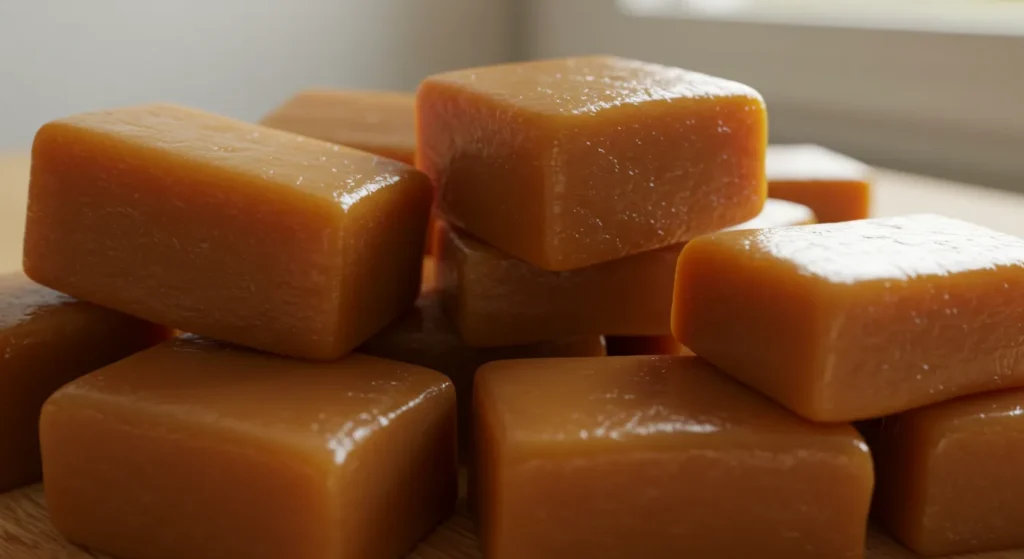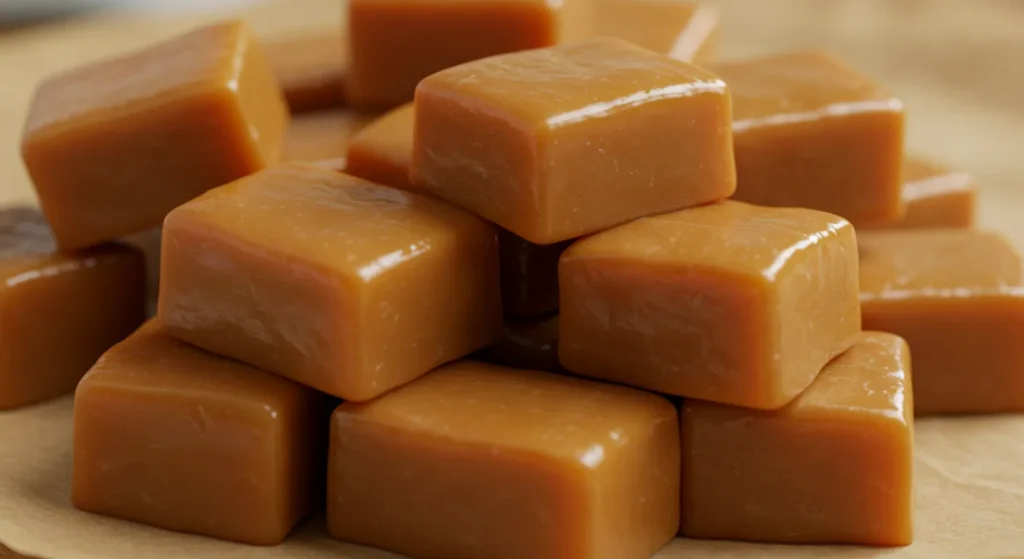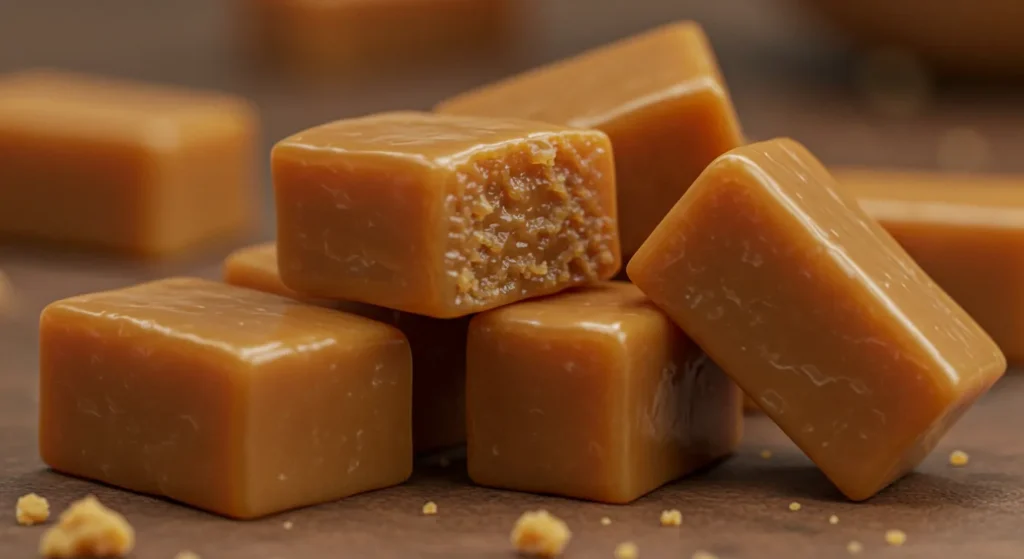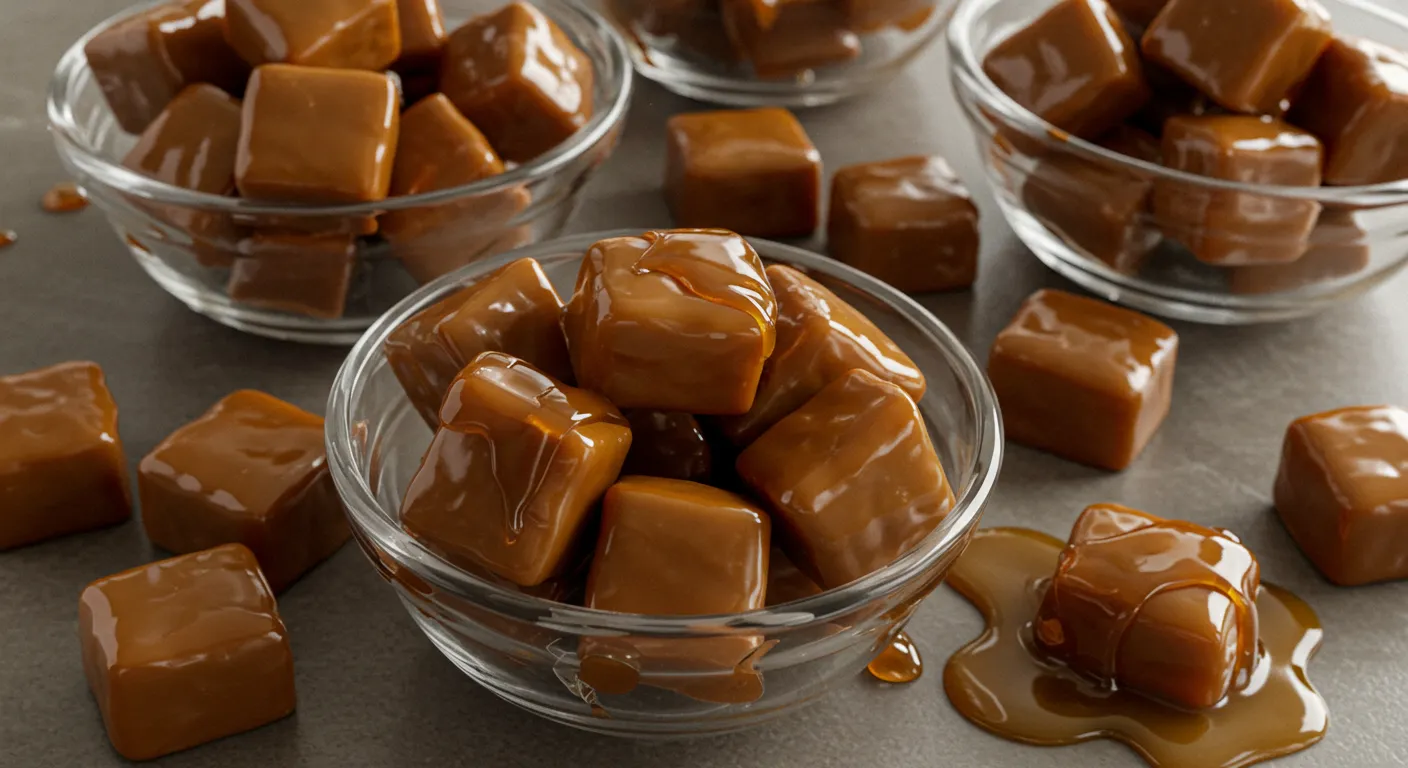
Table of Contents
The sweet smell of caramel reminds me of my grandma’s kitchen. I loved watching her stir golden syrup in copper pots. She made soft caramels that melted in your mouth.
Caramels are more than candy. They mix science with creativity. In the U.S., the caramel market is huge, worth $1.2 billion. Most people like soft, chewy caramels.
Learning to make caramels was a journey. It’s not just about what you put in it. It’s about the magic that happens when sugar turns into a smooth treat. This guide will help you make amazing caramels, whether you’re new or experienced.
Key Takeaways
- Caramels are a beloved candy with a rich culinary tradition
- Soft, chewy caramels are preferred by most consumers
- Making caramels requires precision and understanding of sugar chemistry
- Homemade caramels offer a personal touch to sweet treats
- The caramel market continues to grow and innovate
Introduction to the Art of Caramel Making
Making caramels is a fun journey into sweet treats. It turns simple sugar into a golden delight. I’ll show you how to make these tasty treats that excite your taste buds.
Caramel making is both a science and an art. It needs precision and passion. Sugar turns into a flavorful treat through special chemical changes.
Understanding Caramel Chemistry
The magic of caramel starts with sugar. When heated, sugar changes into a tasty mix. This happens through caramelization.
There are key temperature stages:
- Thread stage: 215°F to 230°F (syrup consistency)
- Soft ball stage: 240°F (soft candies)
- Hard ball stage: 250°F to 260°F (chewy caramels)
- Caramel stage: 320°F (deep golden color)
Essential Equipment for Caramel Making
To make great caramels, you need the right tools. These tools help you be precise and safe. Your must-haves are:
| Equipment | Purpose |
|---|---|
| Heavy-bottomed saucepan | Ensures even heat distribution |
| Candy thermometer | Monitors precise temperature |
| Silicone spatula | Prevents sugar crystallization |
| Parchment-lined baking sheet | Provides cooling surface |
Basic Ingredients Overview
For perfect caramels, use top-notch ingredients. The basics are:
- Granulated sugar (1 cup)
- Unsalted butter (6 tablespoons)
- Heavy cream (1/2 cup)
- Pinch of salt
- Optional: Vanilla extract
“Caramel making is an art that transforms simple ingredients into extraordinary confections.” – Culinary Artisan
Learning these basics will help you make amazing caramel desserts. They will wow your family and friends.
History and Origins of Caramels
Exploring caramels takes us back centuries. The magic of caramelization was first found by Arabs around 1000 A.D. It’s amazing to think of sugar turning into a golden, rich treat that has delighted people for ages!
Caramels have a tasty history of innovation. By the 1600s, candy makers added milk and fats to make the soft, chewy treats we love. North America saw a candy boom, with about 400 candy makers by the mid-1800s.
“Caramel is not just a treat, it’s a delicious piece of culinary history.” – Sweet Historians
- 1886: Milton S. Hershey started the Lancaster Caramel Company
- 1908: William W. Kolb made the candy apple
- 1950s: Dan Walker made the first caramel apple with leftover Halloween caramels
- 1977: Salted caramel was created in France
Caramels kept getting better with time. In 1960, Vito Raimondi made the first machine for caramel apples. The late 1970s brought salted caramel, thanks to French chef Henri le Rou and his use of salted butter.
Now, caramels are used in many foods, from simple treats to fancy desserts. These golden delights keep exciting our taste buds and imagination.
Essential Ingredients for Perfect Caramels
Making the best snacks means knowing the right ingredients. Each one is key to making caramels smooth and tasty. I’ve learned that every part adds to the flavor and feel.
The Magic of Butter and Sugar
Butter is the heart of great caramel. Choose unsalted butter for the best taste. Mix it with sugar for a rich, deep flavor.
- Use 1 cup of premium unsalted butter
- Select 4 cups of pure granulated sugar
- Aim for room temperature ingredients
Liquid Gold: Evaporated Milk
Evaporated milk makes caramels amazing. It adds a creamy touch that’s hard to resist. I use two 12-ounce cans for the smoothest texture.
Corn Syrup: The Secret Weapon
Light corn syrup keeps caramels chewy and smooth. Adding 2 cups gives them a glossy look and a melt-in-your-mouth feel.
“The art of caramel making is about precision and passion” – Culinary Wisdom
My secret? Add a teaspoon of vanilla extract. It makes these snacks taste like gourmet treats. They’re both old-fashioned and fancy.
Step-by-Step Caramel Making Process
Making homemade candy is all about being precise and patient. I’ll show you how to make perfect caramels. They will surely delight any candy fan.

- Heavy-bottomed saucepan
- Whisk
- Candy thermometer
- Parchment-lined baking dish
Here’s how to make caramels step by step:
- Put sugar and water in the saucepan.
- Heat it until it turns deep golden amber.
- Add butter pieces carefully.
- Pour in heavy cream slowly.
- Cook until it hits 245°F (firm ball stage).
“The secret to perfect caramels is patience and precision in temperature control.”
Want to try different flavors? Here are some ideas:
| Variation | Special Ingredient |
|---|---|
| Salted Caramel | 2 teaspoons sea salt |
| Vanilla Caramel | 1 1/2 teaspoons vanilla bean paste |
| Bourbon Caramel | 2 tablespoons bourbon |
Once cooked, carefully pour the caramel into your pan. Let it cool fully before cutting. Store them in an airtight container in the fridge for a month or freeze for three months.
Temperature Control and Testing Methods
Mastering temperature control is key to making great caramels. The right heat turns simple ingredients into tasty treats.
Creating perfect caramels is all about temperature. It’s not just a number. It’s what makes them creamy.
Using a Candy Thermometer
A candy thermometer is your best friend for making caramels. Here are some tips for using it right:
- Calibrate your thermometer before each use
- Ensure the tip doesn’t touch the pan bottom
- Read the temperature at eye level for precision
The Ice Water Test Technique
If you don’t have a thermometer, try the ice water test. It’s a classic way to check caramel without special tools.
- Fill a small bowl with ice water
- Drop a small amount of caramel into the water
- Observe how the syrup forms and feels
Visual Cues for Perfect Consistency
Color and texture also tell you when caramel is ready:
| Color | Consistency | Temperature Range |
|---|---|---|
| Light Golden | Soft Caramel | 240-245°F |
| Deep Amber | Firm Caramel | 245-249°F |
| Dark Brown | Hard Caramel | 250-265°F |
Pro tip: Watch for the caramel’s slow, thick drip from a spoon—this indicates you’ve reached the perfect stage for delicious caramel desserts.
Troubleshooting Common Caramel Issues

Making perfect toffee treats isn’t always easy. Even pros face problems that can make things sticky. Let’s look at common caramel issues and how to fix them.
Soft Caramel Dilemmas
Soft caramels can happen for a few reasons. The main ones are:
- Insufficient cooking time
- Low temperature during preparation
- High humidity in your kitchen
My solution is to recook the caramel. Put the soft treats in a clean pan and heat them up again. Cook for 5-10 more minutes, but watch closely to avoid burning.
Hard Caramel Troubles
On the other hand, hard caramels are a problem too. The main cause is overcooking. Getting the caramel just right needs careful temperature control.
“Patience is key in caramel making. One minute can make the difference between perfection and disaster.” – Professional Candy Maker
To avoid hard caramels, try these tips:
- Use a reliable candy thermometer
- Remove from heat when you see an amber color
- Cool it down fast to stop cooking
Remember, temperature is key when making toffee treats. A little change in temperature can make your caramel go from smooth to hard.
Additional Caramel Challenges
Be careful of these extra problems:
- Graininess: Caused by sugar crystals
- Separation: Often from sudden temperature changes
- Uneven coloring: Usually from uneven heat
Knowing these common issues helps you make perfect caramel treats. Don’t get discouraged by first tries. Practice makes perfect!
Storage and Preservation Tips
Making caramel snacks is like art. But keeping their taste good needs careful storage. This way, your treats stay yummy for weeks or months.
Proper Wrapping Techniques
Wrapping caramels right is key. Here’s how to do it:
- Wrap each caramel in wax paper or parchment paper
- Twist the ends to seal it tight
- Put parchment paper between layers to stop sticking
Temperature and Humidity Considerations
Where you store caramels matters a lot. Here’s a guide to keep them fresh:
| Storage Location | Duration | Recommended Conditions |
|---|---|---|
| Room Temperature | 6-9 months | Airtight container, away from sunlight |
| Refrigerator | 6-9 months | Sealed plastic bag, keep dry |
| Freezer | Up to 1 year | Wrapped tight, use freezer-safe box |
Pro tip: Let frozen caramels thaw for an hour before eating. This makes them soft again.
“The secret to preserving caramels is protecting them from moisture and temperature changes.” – Caramel Artisan
Follow these tips to keep your caramel snacks tasty for months.
Creative Variations and Flavor Combinations
Making unique candies is like art. It starts with trying new caramel flavors. Mixing ingredients in creative ways can turn simple caramels into amazing treats.
Here are some cool ways to make your caramel candies special:
- Classic Flavor Infusions
- Vanilla bean
- Flaky sea salt
- Bourbon-enhanced caramels
- Adventurous Flavor Profiles
- Lavender-honey caramels
- Chili-chocolate swirls
- Espresso-infused caramel
When using alcohol in flavors, remember it boils down fast. Start with a little and taste as you go. This helps find the right mix.
“The magic of caramel-making lies in fearless experimentation!” – Artisan Candy Maker
Seasonal candies are a great idea. Try cinnamon caramels for winter or lavender for summer. Pink Himalayan salt adds a fancy touch.
Pro tip: Use a candy thermometer. Keep the temperature between 245°F and 248°F. This makes your candies perfect every time.
Conclusion
We’ve looked into the world of caramels together. I hope you now feel ready to make amazing desserts from simple things. Making caramels is like art, mixing science and creativity.
It’s fun to make caramels because you can try different things. You can make them soft or crunchy. Every batch shows your hard work and skill.
Think of caramels as a way to connect with old traditions. They can be sweet or salty, showing off a long history of candy making. Start making caramels, share what you make, and enjoy the fun.
Your kitchen is now a place to make yummy caramels. Let your creativity shine and enjoy every bite of your new skill.
FAQ
What temperature is best for making caramels?
The best temperature for making caramels is 240-245°F. This makes them chewy but not too soft or hard. Use a candy thermometer to check the temperature.
How long can homemade caramels be stored?
Homemade caramels can last 2-3 weeks if stored right. Wrap each one in wax paper or cellophane. Keep them in an airtight container in a cool, dry place. Don’t refrigerate unless you must, as it can make them soggy.
Why are my caramels turning out grainy?
Grainy caramels come from sugar crystals. This can happen if you stir too much or if crystals form on the pan. Use corn syrup to stop crystals and avoid stirring once it starts to dissolve. Clean the pan sides with a wet brush to help.
Can I make caramels without corn syrup?
Yes, you can make caramels without corn syrup. Use honey, golden syrup, or pure sugar instead. But corn syrup makes them smoother. You might need to be more careful with substitutes.
How can I add different flavors to my caramels?
You can add many flavors to caramels. Try vanilla, sea salt, or espresso. You can also use lavender, bourbon, or citrus zest. For nuts, mix in chopped nuts or make a nutty caramel.
What’s the difference between caramels and toffee?
Caramels are softer and chewier, cooked to 245°F. Toffee is harder and cooked to a higher temperature. Caramels often have milk or cream, while toffee has just butter and sugar.
How do I prevent my caramels from sticking together?
Cool caramels completely before cutting. Dust the surface and caramels with powdered sugar or cornstarch. Wrap each one in wax paper or cellophane. Store them in a single layer with wax paper between if stacking.
What can I do if my caramels are too soft?
If caramels are too soft, they didn’t cook long enough. Try heating them to 240-245°F again. Or, add them to the pan and cook a bit longer. You can also use them as caramel sauce.

